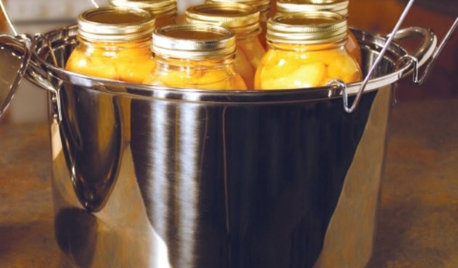Confused about Pressure canning - HELP!!!
rdback
16 years ago
Related Stories

PRODUCT PICKSGuest Picks: Canning, Preserving, Steaming, Dehydrating
20 products to help make fall produce last through the season and beyond
Full Story
KITCHEN DESIGNStay Cool About Picking the Right Refrigerator
If all the options for refrigeration leave you hot under the collar, this guide to choosing a fridge and freezer will help you chill out
Full Story
MOST POPULAR9 Real Ways You Can Help After a House Fire
Suggestions from someone who lost her home to fire — and experienced the staggering generosity of community
Full Story
SELLING YOUR HOUSE10 Low-Cost Tweaks to Help Your Home Sell
Put these inexpensive but invaluable fixes on your to-do list before you put your home on the market
Full Story
WORKING WITH PROS5 Steps to Help You Hire the Right Contractor
Don't take chances on this all-important team member. Find the best general contractor for your remodel or new build by heeding this advice
Full Story
MATERIALSInsulation Basics: What to Know About Spray Foam
Learn what exactly spray foam is, the pros and cons of using it and why you shouldn’t mess around with installation
Full Story
MOST POPULARWhat to Know About Adding a Deck
Want to increase your living space outside? Learn the requirements, costs and other considerations for building a deck
Full Story
ARCHITECTURE10 Things to Know About Prefab Homes
Are prefab homes less costly, faster to build and greener than homes constructed onsite? Here are answers to those questions and more
Full Story
LIFEA Quick Downsizing Quiz for the Undecided
On the fence about downsizing? We help you decide whether that fencing should encircle a mansion or a mini trailer
Full Story
FURNITURESmart Shopper: How to Buy a Mattress
Confusing options, hair-raising prices, haggling ... Our guide can keep you from losing sleep over mattress shopping
Full StoryMore Discussions






dgkritch
kayskats
Related Professionals
West Milford Landscape Architects & Landscape Designers · Leawood Landscape Architects & Landscape Designers · Davidson Landscape Contractors · Lakewood Landscape Contractors · Old Saybrook Landscape Contractors · Oviedo Landscape Contractors · Porterville Landscape Contractors · San Bruno Landscape Contractors · Southbury Landscape Contractors · Streamwood Landscape Contractors · Red Bank Roofing & Gutters · Marietta Roofing & Gutters · Jefferson Hills Roofing & Gutters · Lake Forest Roofing & Gutters · Indio Driveway Installation & Maintenancepetrowizard
dgkritch
rdbackOriginal Author
Linda_Lou
dgkritch
kokopup
traceys
petrowizard
Linda_Lou
fedup321
readinglady
traceys
digdirt2
dgkritch
readinglady
rdbackOriginal Author
prairie_love
psittacine
digdirt2
bejay9_10
ksrogers
digdirt2
ksrogers
kmbchgo
ksrogers